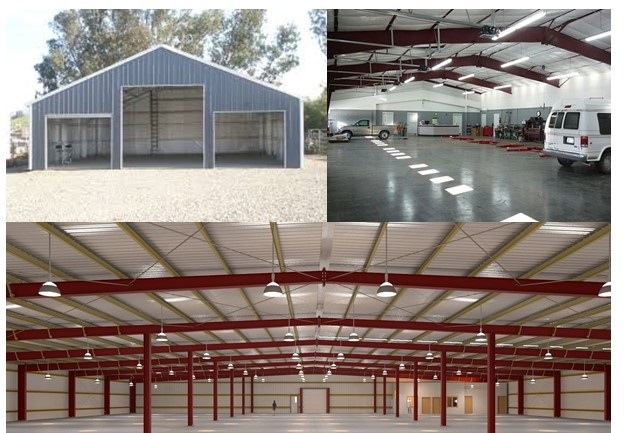Trusted Steel Buildings: Proven Solutions for Agricultural, Industrial, and Residential Requirements
Trusted Steel Buildings: Proven Solutions for Agricultural, Industrial, and Residential Requirements
Blog Article
Expert Guide to Steel Building Layout: Making Best Use Of Performance and Durability
In the world of building and construction, the selection of building material holds paramount importance in determining the performance and long life of a framework. Steel, with its outstanding stamina, resilience, and adaptability, has become a favored choice for contemporary structure design. Designers and architects are continuously discovering innovative ways to harness the possibility of steel in constructing sustainable and enduring structures. From enhancing layout factors to consider to carrying out cost-effective construction methods, the trip in the direction of maximizing efficiency and durability in steel building style is a diverse one, using a blend of useful obstacles and creative options that move the market ahead.
Advantages of Steel Structures
Steel structures supply exceptional sturdiness and cost-effectiveness contrasted to conventional building products. The stamina of steel provides superb architectural integrity, making it a recommended selection for structures that require to hold up against severe climate problems or heavy tons.
In regards to cost-effectiveness, steel buildings are usually much more economical than frameworks made from various other products. The efficient construction process of steel structures can cause reduced labor expenses and much shorter task timelines. Steel's sturdiness additionally converts to lower maintenance costs over time, as there is much less demand for replacements or repairs contrasted to typical building products.
Style Considerations for Efficiency
Offered the advantages of steel buildings in regards to resilience and cost-effectiveness, it is important to concentrate on layout factors to consider that optimize performance and longevity. When developing a steel building for optimal effectiveness, variables such as the insulation, alignment, and design need to be meticulously considered. Effective formats can minimize material waste throughout construction and boost the capability of the structure. Additionally, selecting the best positioning can assist optimize all-natural light exposure, reducing the requirement for synthetic lights and lowering power expenses.

In addition, incorporating energy-efficient systems, such as cooling and heating, illumination, and renewable resource sources, can further improve the effectiveness of steel buildings. By integrating these design considerations, steel structures can accomplish optimal efficiency and durability, offering lasting and cost-effective services for different building and construction tasks.
Architectural Integrity and Long Life

Routine upkeep, consisting of examinations for indicators of wear or damage, is additionally crucial for recognizing and resolving problems prior to they jeopardize the structure's integrity. By prioritizing structural stability in the layout stage and throughout the building's life expectancy, owners can ensure their steel frameworks remain risk-free, efficient, and sturdy for years to come.
Cost-efficient Building And Construction Techniques
Efficient construction approaches play an essential function in managing prices without endangering the quality and stability of steel structure jobs. One cost-efficient approach is using pre-engineered steel building systems. These systems are created off-site and after that assembled on-site, decreasing building time and labor expenses. Additionally, pre-engineered steel buildings are recognized for their toughness and require very little upkeep, leading to lasting price savings.
Another cost-effective approach is the design-build approach, where the style and construction stages are incorporated. This technique cultivates collaboration between the style and building teams, streamlining the process and lessening hold-ups and expense overruns (steel buildings). By including all stakeholders from the start, potential problems can be identified and settled early, saving both time and money
Additionally, taking on sustainable construction techniques, such as using recycled steel and incorporating energy-efficient functions, can bring about substantial expense financial savings in the future. These techniques not just lower building and construction waste yet additionally reduced functional expenses with enhanced energy performance. Finally, applying affordable building and construction techniques is vital for making the most of effectiveness and guaranteeing the longevity of steel building projects.
Upkeep Tips for Durability
Proper upkeep practices are important for making sure the longevity and structural integrity of steel structures. Regular assessments are necessary to determine any indicators of rust, damage, or use that could jeopardize the building's toughness. As component of a comprehensive maintenance plan, it is vital to quickly address any concerns that develop to stop them from intensifying and causing much more comprehensive damage.

Another essential maintenance tip is to examine the structure's welds, fasteners, and links to guarantee they are safe and secure and in excellent problem. Any kind of loose or damaged parts must be fixed or replaced quickly to preserve the architectural stability of the structure. By executing an aggressive upkeep routine, steel structure proprietors can take full advantage of the longevity and performance of their frameworks.
Verdict
In conclusion, steel buildings offer many advantages such as longevity, cost-effectiveness, and performance. By carefully taking into consideration style elements, guaranteeing structural integrity, and making use of cost-efficient building and construction techniques, steel structures can be maximized for optimal performance and longevity.
From optimizing style factors to consider to implementing cost-efficient building techniques, the trip towards maximizing performance and longevity in steel structure design is a multifaceted one, supplying a blend of functional obstacles and creative solutions that thrust the market forward.
Provided the benefits of steel buildings in terms of longevity and cost-effectiveness, it is critical to focus on style considerations that maximize performance and long life. When creating a steel structure for optimal efficiency, variables such as the positioning, insulation, and design have to be thoroughly thought about. In conclusion, executing cost-efficient construction methods is crucial for taking full advantage of efficiency and guaranteeing the durability of steel building tasks.
By carefully thinking about layout aspects, making sure architectural stability, and using affordable construction methods, steel structures can be optimized for maximum effectiveness and durability.
Report this page